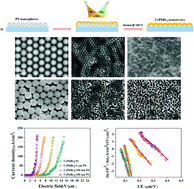CsPbBr3 microarrays with tunable periodicity, optoelectronic and field emission properties using self-assembled polystyrene template and co-evaporation method†
Abstract
The booming growth of all inorganic cesium lead halide perovskites in optoelectronic applications has prompted extensive research interest in the fabrication of ordered nanostructures or microarrays for enhanced device performances. However, the high cost and complexity of commercial lithographic approaches impede the facile fabrication of perovskite microarrays. Herein, CsPbBr3 microarrays with tunable periodicities have been fabricated using a self-assembled polystyrene nanosphere template and a co-evaporation method. The periodicity of CsPbBr3 microarrays is precisely manipulated by simply modifying the size of polystyrene nanospheres. These microarrays are beneficial for light harvesting, leading to better light absorption ability and prolonged photoinduced carrier lifetime. The longest average carrier lifetime of 58.3 ns is obtained for CsPbBr3 microarrays with a periodicity of 1.0 μm. More importantly, the periodic structures of CsPbBr3 microarrays result in a tunable density of emitter tips in field emission devices. Compared to compact CsPbBr3 films, a 68.2% decrease of the turn-on field is observed for CsPbBr3 microarrays when the periodicity is 150 nm. The higher density of emitter tips leads to larger local field enhancement, and hence the largest field enhancement factor of 3346.6. Finally, a good emission current stability for CsPbBr3 microarray-based field emission devices has been demonstrated.



 Please wait while we load your content...
Please wait while we load your content...